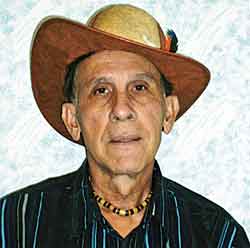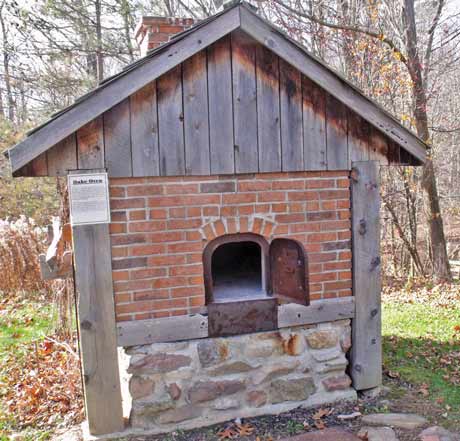November 16, 2011 issue
Arts & Entertainment
Long time ago quality bread was the toast of town

Bernard Heydorn
Bread, called the staff of life, has been a food staple since the beginning of recorded history. In the Caribbean, rum has sometimes been confused with bread as the staff of life!
The ancient Egyptians baked bread before the 20th century B.C. There were public ovens in ancient Rome and the bakers of Greece were world famous. It has been written that a substance called "manna" (wafers) was sent down from Heaven to feed the Israelites in their journey through the wilderness.
Around World War Two, a whiter more refined flour was introduced that eliminated many of the vitamins and minerals from flour. The U.S. government as a public health measure required that the missing vitamins and minerals be replaced, hence the beginning of the "enriched white bread".

Bread loaves of the 19th and 20th centuries were often large and round. The loaves had a nice crust and "a spring" in them when you pressed them in with your finger. The smell of fresh and baking bread could be discerned from a mile off!
On the contrary, bread baked today has no "spring" – a white, cotton substance with little taste or smell. Bread these days remains soft, fresh and fluffy for a longer time. It is said that rodents turn up their noses at modern bread. Perhaps they are concerned with the lack of vitamins and minerals!
The supermarkets today give a long list of the ingredients and chemical additives in bread. Written in fine print on the bread wrapper of see-through plastic that my old eyes can barely see, they assure us that the ingredients are harmless, enhance the flavour, and prevent the goodies from spoiling. The packaging also adds to the look of the finished product.
Compare that to the bread delivered on carrier bikes from the baker-shops in the old days. Bread carts pushed or horse-drawn were also used in town and country. Baking was done at night and during the early hours of the morning. A bleary-eyed baker was a common sight during the day in a baker shop.
I have to say that I do not eat much of the modern bread which I see as a "filler". Restaurants often offer lots of bread before a meal. When I was a child growing up in New Amsterdam in the 1950's, my mother used to knead flour at home to make bread, in order to economize and make ends meet.
Those were "guava days" of scarcity for the family. She made "plait" bread - plaits of kneaded dough (flour and ingredients) and "pan" bread, set in small oblong pans. I would set off to a baker-shop on Main Street not far from the Public Gardens to have the dough baked. On the way home, the baked bread would be smelling me up and not being able to pinch off an end and eat it was quite a frustration.
When I attended St. Aloysius R.C. School (Cintra House) in New Amsterdam, there was Choo-Kang bakery located across the road on New and Main Streets. It was one of my chores to buy bread for the family from Choo-Kang Bakery after school had ended in the afternoon.
The baker at that time of the day was often so exhausted that he had fallen asleep and I had to wake him up. I could choose what loaves of bread I wanted. He used his "baker's peel", the long stick with a flat end that got the bread in and out of the oven, to meet my requests. Nearby stood the fire rake. He would sometimes give me a sweet bun at no cost, much to my delight.
In the 1960's when I lived in Barbados, I often bought bread from a bread cart by the market and bus stand in Bridgetown. The bread cart was pushed up Britton's Hill and past our house in the late afternoon. The vendor would open his cart and a cloud of trapped flies would rush out! Their places would be taken by a new batch rushing in to sit on the sweets, breads, cakes, sugar and all the goodies. The sweating bread cart man would try to brush the flies away but it was a losing battle.
The bread would come from bakeries like Purity, established since the 1930s. Ironically, even though the bread had left Purity bakery quite fresh, pure and healthy, perhaps the same could not be said when it hit the streets. In any case, this did not seem to deter the hungry customers clamouring around the bread cart.
In the early 1960s during the political turmoil in Guyana when a long general strike was in progress, flour was scarce. I used to join a long line of hopeful customers, waiting outside a bakery to buy a rationed loaf of bread. Things got even worse after Guyana achieved independence and the Burnham regime stopped the importation of wheat flour. Residents were forced to use local rice flour and cassava flour to make their bread, roti, pastries and cakes. Needless to say, this did not sit well with the citizens of Guyana.
Well known bakeries in Georgetown were Tang's on Robb Street, Dictator on James Street, and Sadler's on Crown and Albert Streets.
Some of the older folks may remember the different types of bread that were baked in Guyana. They include aniseed bread seasoned with aniseeds. This type of bread was, I believe, given to the poor in churches on the Feast Day of St. Anthony. There was Antigua bread, butter bread made with butter, butterflaps, cottage bread, pan bread, plait bread, collar, salara (bread and cakes) penny loaf bread, coconut bread, sweet bread (heavy or light), flavoured with gratings of coconut, raisins and spices and round bread. Last but not least there was doughboy bread, a subject unto itself.
Doughboy was a small hard, homemade sweet bread, sometimes made with coconut milk, and a little baking powder. It did not rise too much because it was made from pieces or ends of kneaded dough. It became a staple for poor folks. Looked down upon by other groups in society, doughboy was welcomed by the needy.
Today there is whole-wheat (brown) bread and rye bread which are more nutritious. In the early 1970's, I lived in the town of Gaspé, in the Gaspé Peninsula in Quebec, 600 miles from Montreal. As I drove along the winding highway on the banks of the St. Lawrence River, I remember seeing outdoor brick ovens for baking bread.
These ovens, historically made of clay, brick or stone, were a very common sight in rural Quebec in the 19th century. The materials used to make the ovens depended on the wealth of the home owner and the availability of suitable building materials in the surrounding country side.
Often called "beehive" ovens, because of their domed, horseshoe shape, some were built indoors, some adjoining a house or outdoors in the yard. The clay ovens reportedly made the best bread. Brick ovens were regular shaped with simple lines and often made by bricklayers. Stone ovens date back many years in Quebec to the 17th century or even before.
Baking ovens had many uses besides making bread, pastries and other goodies. When cooling they could be utilized for different types of cooking including pork and beans, meat pies (tourtières), pot pies, other meats, desserts, cookies, buns, raisin cakes and fruit cobblers. A warm oven could be used as a sterilizer to disinfect chicken, duck and goose feathers used for stuffing pillows or cushions. During illness, the clothes of the sick were also disinfected in the ovens.
At harvest time, the drying of the flax was made easier by placing it in ovens prior to hackling (mangling) it. It was used as a drying room for homespun cloth. Carpenters took advantage of the warm oven to dry out the wood. In the absence of a smokehouse, the oven was used to cure meat.
A week's supply of bread was baked at one time. A sprinkling of flour at the door of the oven gave an indication if the oven was too hot (flour turned black) or just right (flour turned brown), for baking. Coals were put down a trapdoor in front to feed the fire. Brick ovens are still being made and used these days.
Over the years bread has been portrayed by painters and sculptors and in works of art. It is part of our culture and civilization. Like the poor, it seems that it will always be with us. Canada continues to produce flour that feeds many millions around the world. Unfortunately there are still many folks who cannot afford to buy bread.
I long for the days when bread was bread, one of the most healthy, tasty and appetizing foods around. Ah gone to toast a slice of bread to give it some taste and flavour. If the creeks don't rise and the sun still shines I'll be talking to you.